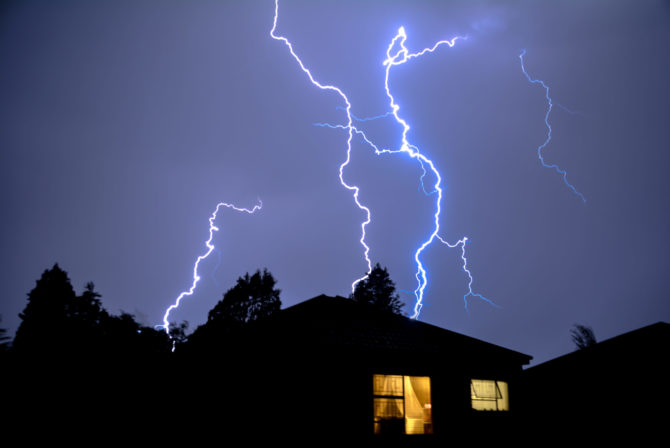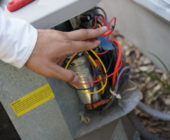
Though we usually associate summer with bright, sunny days and exciting vacations, the season has its downfalls. Namely, Atlantic hurricanes may whip through the Southeast as early as June. These storms — along with other severe weather like hail downpours — can wreak havoc on your home’s HVAC system.
When preparing for any unpleasant conditions, don’t neglect your air conditioning unit. Post-storm AC repairs can be quite costly, adding unnecessary financial stress on you and your family.
If your unit has already suffered weather damage, schedule a service appointment with Champion AC today. We offer a broad range of services to address all heating and cooling malfunctions. Meanwhile, even if your system is in good shape, consider adopting the following practices to defend your air conditioning:
Steps Before the Storm
Keep Your Home Cool
In most homes, a power outage results in deactivated cooling units and unpleasant temperatures. Therefore, it’s best to set your thermostat lower than usual before extreme weather arrives. This will pump more chilled air into your home, keeping indoor temperatures reasonable during a storm.
Alternatively, you may want to connect with a San Antonio AC company for help installing a generator. This will help keep your system functional through intense conditions.
Seal Windows and Doors
Check that all your windows and doors aren’t letting in an outside breeze. This will also help with temperature regulation, as warm outdoor air won’t have a chance to overheat your home. Furthermore, properly sealed windows and doors will guard against leakage during a rainstorm.
Cut the Electricity
A thunderstorm-induced electrical surge can destroy your cooling unit, necessitating expensive AC repairs. By turning off your electricity (ideally from your thermostat and circuit breaker), you eliminate the possibility of this kind of damage.
Secure or Cover Outdoor Units
Extreme winds can sweep leaves, dirt and other items into outdoor units, leading to malfunctions down the road. Make sure to cover your AC with a tarp, wood or more impenetrable materials to guard against debris and rain.
Consider a Generator
Generators are handy machines that run on gas, meaning they’re perfect for severe storms that cause power outages. Some generators are even programmed to automatically turn on when your power goes out.
Having a backup generator is a great investment because it can ensure that your air conditioner stays running, even in the worst of storms.
Surge Protection
Power surges happen when there is a big spike in your electrical system’s current. Power surges can cause a variety of issues in your home such as:
- Flashing electrical appliances
- Burnt odors coming from your devices
- Damage or broken machines
To protect your home against surges, you may want to consider buying a surge protector. You can invest in whole-home surge protection that will defend everything that is connected to your electrical system, or you can connect individual surge protectors to your major appliances and equipment.
Furthermore, if you have a unit on your second story, use hurricane straps to secure the system to the wall. This can stop a catastrophic fall amid wind gusts.
Steps After the Storm
Check for Damage
Following any extreme weather, it’s smart to examine your home for damage. Begin by walking along the perimeter of your house to identify exterior harm. Make notes and take photos of any issues, as this can be used to file insurance claims.
Unfortunately, interior problems are much harder to see. If your cooling system has stopped working after a storm, you can reset your air conditioner following the steps in the next section. However, for damage that’s more difficult to spot, call Champion AC to have your entire system assessed.
Reset the Air Conditioner
As previously mentioned, resetting your air conditioner should be your first move after a storm. Walk through the steps below before calling an HVAC technician, as a simple system restart can address a multitude of issues.
- Deactivate the AC (with your thermostat): Using your thermostat, turn off your air conditioner fully. You should follow this step even if your system doesn’t appear to be working.
- Switch off the breaker: Find your home’s breaker, which is usually in the garage or basement. Opening the breaker box, find the switch specifically for your HVAC system (it should be labeled) and turn it off.
- Switch on the breaker: Immediately afterward, flip this switch back on.
- Wait half an hour: Afterwards, leave your thermostat and breaker alone for around 30 minutes. Within half an hour, your air conditioner should reset without further interference.
- Reactive the AC: Finally, returning to your thermostat, turn your air conditioner back on. Afterward, your cooling system should run smoothly.
If you go through this process and your AC is still malfunctioning, it’s time to seek professional help.
Finding a San Antonio AC Company
The team at Champion AC can guide you through pre-storm and post-storm maintenance. Request a service appointment with us today to address any air conditioner problems following extreme weather.




